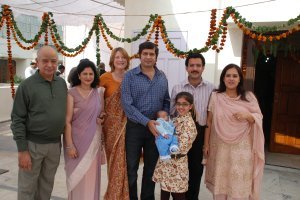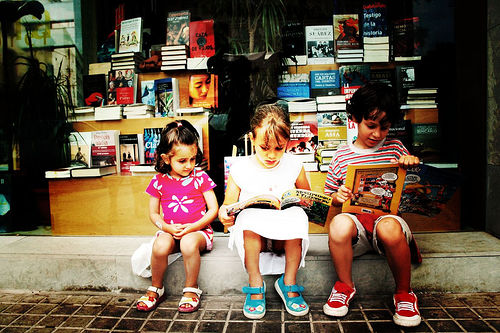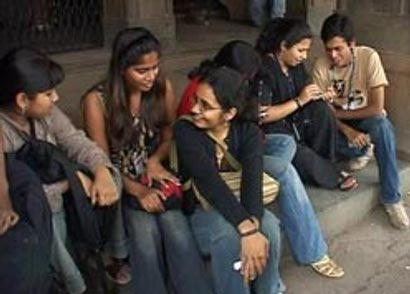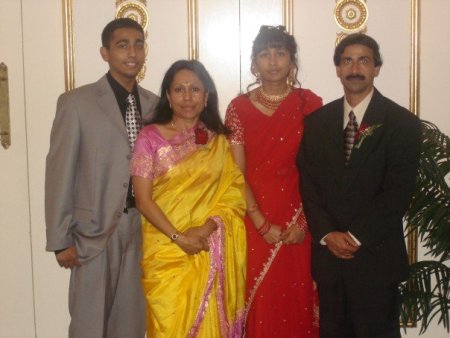From The Peopling of New York City
This section is primarily focused on the impact of immigration on the family, especially youth. Here, we are specifically observing the ways family structure and tradition are carried over from South Asia to America. We ask ourselves, "Is it possible for a family to retain all customs practiced in the home country, or will the influence of American culture inevitably penetrate through?" We are interested in studying the changing dynamic of the family, as it progresses from immigration towards assimilation. Of particular interest is the effect of this change on the youth. How do South Asian immigrants' children, who are often more heavily exposed to American culture than their parents, see themselves? Do they ever struggle with the conflicting ideologies of tradition and Americanization? This section attempts to answer these and other questions concerning changing families of South Asian immigrants.
Contents |
The Importance of the Traditional Family

South Asians, whether they are Indian, Pakistani, Bangladeshi, etc., have a very personal and deep relationship with their family members. This is evident just walking through the streets of Jackson Heights, where families spend much time together. To realize the importance of the family unit in South Asian life, we have to take a look at its significance in the home country. For example, in India, it is often times very common for young people to live at home with their families until they are ready to be married. At this point, one of the most crucial family traditions is evident: the arranged marriage. Portrayed as insensitive or even backwards among people in the United States, the arranged marriage is a long tradition that serves to put kids' trust in their parents. At the same time, the arranged marriage also brings together two families, making it not only more extended, but more intimate. The stress of the family is also seen in the living arrangements of various types of South Asian families. It is extremely common to see large families, extending to grandparents, aunts, uncles, etc., living in one house. This arrangement often times brings the family closer together, while at the same time rationing out different responsibilities to its members. Women may stay at home together, making the kitchen their own domain. The men go to work, while the children attend school. The role of elders is also very important: they are the ones given the utmost respect, and often times are responsible for the decisions being made in the household. In this typical setup, the family becomes central to the lives of South Asians. It is easily one of the most important aspects of Desi life, and goes so far as to define the roles of people living in South Asian countries. This strict structure, although changing as India becomes more involved in the global economy, becomes a tradition as generation after generation repeat the same kind of lifestyle.
The South Asian Family in America
While tradition and custom reign in native countries of South Asia, how do they fare when Indians, Pakistanis, Bangladeshis, etc. immigrate to America? What is held on to, and what gets "replaced" by American culture? Immigration to a foreign country is undoubtedly a difficult experience, no matter from where the transition is made. In doing so, family traditions risk getting lost. Certain traditions (or possibly "cultural habits"), such as living in large, extended families and having an arranged marriage, may get replaced by American ideals about nuclear family housing and marriage for love. Other times, there is a change in ideology. For example, an Indian or Pakistani teenager may desire more autonomy and privacy than his immigrant parents are willing to give him. The generational gap for children of South Asian immigrants may be greater than for kids with American parents, for they have to overcome not only differences due to age, but also those due to a different cultural upbringing. This could mean listening to different kinds of music, watching different kinds of television programs, spending time with non-Asian friends, or dropping the native language. All of these cultural pressures put stress on the family to keep up customs, and risk them being lost in the noise of America. As this happens, families may move further apart, due to the lack of connection typical of traditional South Asian families.
A similar story is found in Sunita, an Indian immigrant and owner of Shri Krishna Jewelers on 74th Street of Jackson Heights. The Interview with Sunita reveals the other side of the family question: the parental side. Even though Sunita had a traditional upbringing in India (with an arranged marriage), he, too, is comfortable with America and its influences on his children. He, like many other South Asian immigrants, is confident in the way he raised his children. He explained that throughout his kids' childhood, the family was very close, including yearly trips to India. "We gave them that teaching. We [the parents] go to the same places as the kids, and so we spend a lot of time together," said Sunita. At the same time, Sunita never pressured his children to go into a certain profession, and allowed them to go away to college as well. Sunita has a "big picture" idea about the way to keep his family close. He has found a way to balance his Indian customs with his kids' American desires, and has been quite happy with the results. His example, in addition to Jeffin's, shows the coming together of cultures in America. There is not necessarily a blending of the cultures, but more like a cohabitation. The availability and openness of South Asian parents, in these cases, seem to determine the relationship between child and parent, without having to sacrifice the attachment to South Asian culture.
Jackson Heights: Crossroads of Culture
Whether or not they are willing to assimilate into American life, most South Asian parents desire a space where their native culture can become embedded into the psyche of their American-born children. This is where Jackson Heights fits in. The somewhat small area between 73rd and 75th Streets, between Roosevelt Avenue and 37th Avenue, is home to a variety of establishments that bring the South Asian family close together through tradition and custom. This "Little India" presents authentic, South Asian restaurants, sari shops, Bollywood music and movie stores, Desi-style jewelry shops, and other places where the South Asian family can spend time. A family swept up in the hustle-bustle of New York City can dine casually in one of the many dosa or kabob houses. A mother and daughter, in preparation for an upcoming wedding, can stroll along 74th Street, searching for the perfect, traditional Indian wedding gown. Other families may go to the movies together to see a Bollywood movie, native to India, or just walk through the neighborhood window-shopping. Indeed, when going to Jackson Heights, particularly on a weekend, it is impossible to miss the dozens of families walking along the street, participating in all of these activities. The family feels that they have become part of a community, where shared interests and experiences come together. As a result, South Asian parents find Jackson Heights to be a haven where they can expose their kids to their own culture.

However traditional Jackson Heights may be, one cannot ignore the penetration of other groups into the neighborhood. Whether they are American banks or Latin eateries, these groups add a different aspect to Jackson Heights. It is this mixture of cultures in the area that leads South Asian children to define themselves as Bangladeshi-, Pakistani-, or Indian-Americans. Jackson Heights is symbolic of the cohabitation of American and South Asian culture in first-generation Americans, such as Sunita's children or Jeffin Mathew. Thus, Jackson Heights is the bridge between the "old" and the "new." Parents can introduce their children to their heritage, and at the same time accept the fusion of parts of American society. This has created a new culture among South Asian children that stresses the importance of their ethnic customs, while at the same time implants the new ideals and values of American society.
Youth
To young South Asians living in their home countries or living in America, family is the most important thing in the world. The children are expected to put their family above anyone and anything else, and do so willingly. No decisions are made without the approval of their parents and relatives.
The transition between India and America had a huge impact on the younger generation of people that live around or visit Jackson Heights. There are several differences in their expectations from the family, from what they can do that night to the following weekend to five years from now. The general trend is that parents are becoming less conservative with their children and adopting more American views.

Aside from family outings to the movies and shops, the younger generation is also expected to accompany family to temple every week. As with any young child with regards to something they are forced to do, the children were reluctant to go when they were little. As they grew older, however, it became tradition. It had turned into habit. Some families will even go to multiple temples each week. One young South Asian that frequents Jackson Heights, Maya, will go to a minimum of two temples each week. She grew up being forced to go to temple every week, and now it is part of her life and she considers herself very religious. Going to temple is a very important aspect of her family's life, as well as many other families’.
Even for the future, South Asian parents are extremely involved in their children’s lives, though those living in America are generally more liberal. While traditionally in South Asia, parents arrange marriages for their children, many immigrant families are now giving more freedom to that decision. Most South Asian children understand the value of arranged marriages and even consider it to be a good back-up plan if they are unable to find love within what they consider to be a reasonable amount of time.
Also, one thing that South Asian parents consider to be most important, after family of course, is education. Jeffin Mathew says that his parents do not particularly care what exactly he chooses to study. All they care about is that he gets a complete education and does something with his life. He also says that is what most Indian parents want of their children. This is particularly interesting because it shows a similarity between South Asian ideals and American ideals even without mixing first. American parents generally expect their children to go to school and complete at least one degree in order to make something of themselves. Just like South Asian parents, American parents will usually allow their children to choose whichever subject they would like to study, though you do get the occasional parent that will choose for the child, as there is with any other culture.
While many families living in America keep many traditions alive from India, like going to temple or spending time with each other, many others are adapting to the new environment as they mix with the American culture. Arranged marriages are not as common, though they still exist and some young people actually embrace it. Some will even consider dating in the traditional American sense, though their parents may or may not approve, such as Maya's sister. The family has found new activities to participate in to spend time with the people who matter most to them, their family. It is a great thing for a people to grow and adapt as they keep the things in their tradition that work and are helpful and change the things that may not be best for them to pass on to the next generation. Jackson Heights, being the vertex connecting South Asia and America, as well as the melting pot of other peoples that have called Jackson Heights their home, is a wonderful place for this to happen.
Content written, edited, and compiled by Joshua Petimar and Amelia Blackwood.

